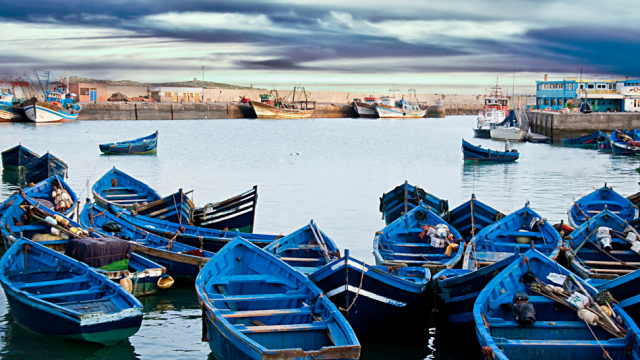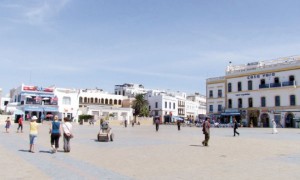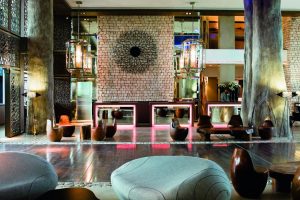The enchanting seaside town of Essaouira has a special appeal. It’s smaller and less frenetic than Marrakech and Casablanca, and virtually unspoiled by modernity and commercialization. Those looking for a more “authentic” Moroccan experience come here to explore the historic 18th century fortifications and colorful alleyways, to wander through the shops, souks and art galleries, and to relax in the beachside cafes.
Moroccan families escape to Essaouira during the summer to avoid the heat of the interior, while international tourists come year round to surf, laze on the beach and enjoy the easygoing vibe – which is why the town is also known as Morocco’s premier seaside destination.
History and Orientation
Essaouira has been occupied since prehistoric times, and has operated for centuries as a trading post on the Atlantic Ocean. Over the year Carthagians, Romans and the Portuguese all set up establishments here, but it wasn’t until the 18th century that what we know as present-day Essaouira came into being. Ruler Mohammed III wanted to reorient his kingdom towards the Atlantic for easier trade with European powers, and quickly established the large harbor and fortifications that still remain today.
The city is located on the coast of Morocco, around a four-hour drive south of Casablanca, and about a two-hour drive west from Marrakech. The western side of the city faces the Atlantic Ocean and is full of fortifications and plazas that are popular for strolling or idly sitting and watching the waves crash. Several popular beaches are also in the area. The rest of the city is centered around the medina, which is shot through with dozens of labyrinthine pathways.
Attractions
A fine piazza at the Place Moulay Hassan greets tourists at the entrance to the souks, where you can relax in one of the many cafes. Turn to the left and follow the alleyways abutting the rampart walls lined with an array of shops. A cobbled ramp leads up to the Scala (cannon battery) and the ramparts, with a line of engraved cannons emblazoned with their maker’s names and cities facing out to sea.
Descending the ramp underneath the ramparts, you’ll find wood carving shops full of elaborate enameled boxes, chess sets, trays, tables and backgammon and dice sets with the deep scent of the resin from acacia, ebony, thuya and eucalyptus wood.
Walk through streets packed with stalls selling carpets, kelims, scarves, ceramics and brassware mixed in with small hanouts (stores) selling everyday items including spices, ancient remedies and traditional Berber cosmetics including black soap.
After you’ve done a bit of shopping, walk down to the walled harbor, the Skala du Port, and see wooden fishing boats being built on the harbor quay and fishermen tending their nets. They bring in their catch at the end of the day in their small deep blue boats. Eat freshly-caught grilled fish at Sam’s, a famous fish restaurant alongside the pier wall, as gulls swoop in and try to grab their share.
If you’re not that hungry, grab a small lunch on the terrace at the Café de la Plage instead, and look out over the beach and the deep blue sea where windsurfers with colored sails fly by on their surfboards, and young Moroccans play football and swim. Along the beach, camel and horse owners walk up and down looking to take tourists for a ride. There is a ruined tower (the Borj el Berod) further up the beach, and you can look out to the mysterious island with its long-abandoned mosque and village. It can be visited at some times during the year, provided you get a permit from the port authority. If you feel inclined, local fishermen can arrange boat trips to take you out.
To get a feel for Essaouira’s history and cultural heritage, head to the Sidi Moulay Ben Abdellah Museum, which has a collection of old photographs and a fascinating display of costumes, musical instruments and silver Berber jewelry. For more jewelry, you can also head to the Berber jewelry souk between Avenue l’Istiqlal and Rue Sayaghine.
Essaouira has also developed as a thriving cultural center with art galleries such as Galerie Frederic Damgaard, the oldest gallery in Essaouira, which displays the work of local artists and colorful African paintings and sculptures on Av Okba Ibn Nafia. Another great place to check out is the La Petite Galerie near the Rue Ibn Rochd passage to the north of the main square, it’s a nice getaway from some of the bustle of the streets. Other great places to check for the arts include Espace Othello, the Association Tilal, and the Taros Café — which has a bar and restaurant, and hosts art and crafts exhibitions throughout the year.
Depending on the time of year you’re in town, Essaouira has many of the most famous festivals in Morocco. Festivals include the International Gnaoua Music Festival held every year from June 12-15. International and Moroccan musicians perform at this world class music festival which also celebrates the Sufi spirituality of traditional Gnawa. The musicians use the pounding beats of drums, hypnotic reed pipes and other instruments to work people into a frenzy. If you want to attend the event, book accommodation well in advance. Another great festival to check out is the Alizés Spring Musical Festival in May, celebrating classical music and Opera. If you’re there in the fall, Festival des Atlantiques Andalouises in late September features Morocco’s great Andalusian musical and dance heritage. Just be aware that hotel room rates go up when there’s a festival in town.
Dining
With its coastal location, Essaouira certainly has no shortage of delicious food. For a lively atmosphere that’s packed with 70’s memorabilia, head to Elizir. The owner is Abdellatif Rharbaoui who spent time in Italy and learned Italian cuisine. It has only 30 tables so it’s a must that you book ahead. If you’re meeting up with people and want some of the freshest seafood in the city, check out the Taros Café Place. It has great views of the Medina and port from the terrace. Another great place for fish is Chez Sam, the port restaurant built at the end of the pier. This wooden structure is one of the oldest restaurants in town. Known for superb fish and slightly chaotic service. It has a superb view, so try and get a table on the terrace. Right down from there is Le Chalet de la Plage on Boulevard Mohamed V. It was opened in 1893 and is the place for lunch with a fantastic view of the beach and the sea. Service is excellent and fish meat or salads are great. For more outdoor dining, head to L’Heure Bleu Dine and have lunch outside. With international and Moroccan cuisine, this gourmet restaurant is one of the best in the city. Head to La Licorne for a great fine dining option. It serves excellent Moroccan cuisine coupled with delicious wine in a great atmosphere.
Where To Stay
Essaouira has over 144 hotels and riads to suit all budgets. For those in town for a few days, we recommend trying out one of the modern hotels, along with a riad, so you can get the best of both worlds.
If you’re there to enjoy the beach, it doesn’t get much better than the Heure Bleue Palais. It’s only 400 meters from the beach and has stunning views of the Medina from the terrace. All bedrooms have flat screen TV’s and marble bathrooms, along with a heated outdoor swimming pool and fireplaces for when it’s winter. Inside, the Courtyard patio restaurant serves international and Moroccan cuisine. The English lounge features comfy leather armchairs, a fire place for winter and a well stocked bar. Free WiFi is available in the public areas which includes a cinema, hammam and a massage parlor.
Atlas Essaouira & Spa is another modern five-star hotel on the seafront. It’s ideal for families who want to be near the beach. It features two swimming pools, and a hammam and spa with sauna. Bed rooms are air-conditioned and have ensuite bathrooms. Try to get a bedroom with a balcony for a great view.
If you want to hit the links when you’re in town, check out the Sofitel Essaouira Mogador, it has a Gary Player designed golf course and a Villa des Enfants for when parents want to take a break. However, it’s a little far out so you will need to take a shuttle bus to get into the city centre.
If you want something closer in, go to the Riad Mimouna. It’s centrally located in the Medina and is traditionally decorated with great design throughout. Some rooms have great panoramic sea views, so be sure to ask when booking. After a day walking around, it’s a good place to relax at as there is an onsite hammam as well.
Excursions
Just outside the city, Sidi Kaouki has a beautiful unspoiled beach that’s only 25km from Essaouira and is excellent for surfing. Farther afield, Oualidia is 190 km away and has a delightful, wind-sheltered lagoon — excellent for surfing, swimming and sailing. It’s also famous for oysters, seafood, flamingos and birdlife. You can find surfing equipment at Magic Fun Africa and Ocean Vagabond, who both provide surfing lessons. The nearby village of Diabat has horseback riding in the countryside at Ranch de Diabat or Abouda Safar. The really adventurous can take extended camel rides with Maison du Chameau. Another option is to take a trek in the countryside, crossing the source of the Kosob River, and seeing the remains of an ancient Roman viaduct.
Getting There And Around
There are several direct flights into Essaouira from major European destinations such as Paris and London, or if you’re in the south of France, you can get super-cheap flights from Marseilles. You can also easily get in to the city from Marrakech via grand taxi, which will run anywhere from 400dh to 1000dh, but there are also tourist transfer services and coach operators available. Supratours runs reliable coach service from Marrakech’s bus station. Trains do not run to Essaouira.
Once in the city, taxis are readily available, but one can easily get around on foot. The medina in the center of town is restricted to non-motorized vehicles which makes it easy for walking, but you should still be on the lookout for them, as not everybody in the city actually obeys this rule. If you want to rent a car to get around, the only international firm with an office in the city is Avis.
Practical Considerations
Location: Essaouira is located on Morocco’s Atlantic coast, and is protected by a natural bay. It’s approximately 373 km (203 miles) southwest of Casablanca and 175 km (149 miles) west of Marrakech.
Weather: The city has a mild climate year round due to its coastal location. Temperatures average 19C (67F) in July and only drop down to around 15C (58F) in January.
Languages: Moroccans primarily speak Arabic and French, though English, German, French and Italian are fairly common in touristed areas.
Health and safety: Although pickpocketing is common, keeping a tight grip on your valuables in crowded places is an easy way to avoid it. Western women often get excessive attention from men, particularly if walking alone. Just ignore it and do not make eye contact. Scams are not near as common here as in cities such as Fez and Marrakech, but you should still be on the lookout just in case.
Local customs: Women are advised to cover their shoulders and legs in public areas. Swim suits on men or women are acceptable only in beach or poolside locations. Also, when in mosques or other holy sites, women must cover their hair.
Money: The national currency is the dirham, abbreviated Dh. It’s best to change money once you enter the country, not before, as few banks overseas carry the currency. You can exchange money in a bureau de change, a bank or a hotel (most hotels will exchange at the same rate as banks and without charging commission). Most upmarket restaurants, shops and hotels or riads will accept credit and debit cards (just not American Express). Banks are plentiful, and ATMs can be found all over the city and in many hotels.
Hospitals:
The public hospital is located just outside the Medina from Bab Marrakech, on boulevard de l’Hôpital. Dial 0524/475716.
Emergency numbers:
- Fire Department & Ambulance: Dial 15
- Police: Dial 19
- Private Ambulance: Dial 0673/209652
- Mogador Assistance: Dial 0661/247624
Further information: Moroccan National Tourism Office
This article was originally published on August 11, 2014.





